




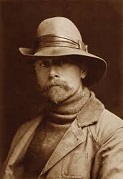
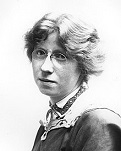
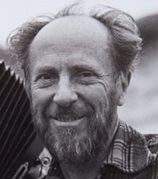
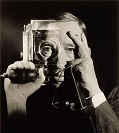

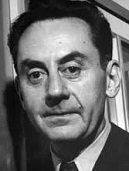
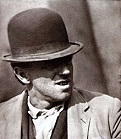
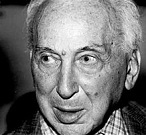
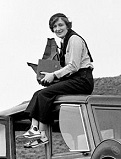
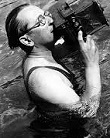

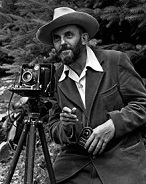



















TLW's Photographerscope™ (Photographer Historyscope) |
By T.L. Winslow (TLW), the Historyscoper™ |
© Copyright by T.L. Winslow. All Rights Reserved. |
Original Pub. Date: May 10, 2018. Last Update: Apr. 25, 2020. |
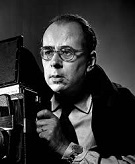




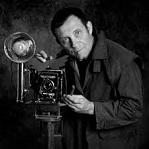
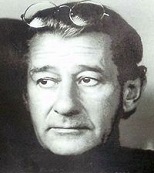
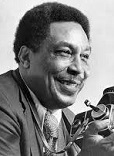
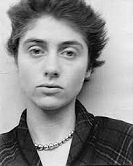

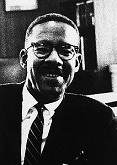
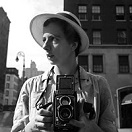
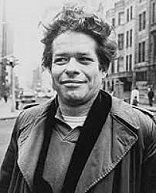
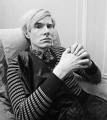

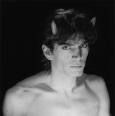
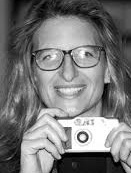
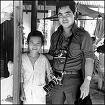
Westerners are not only known as history ignoramuses, but double dumbass history ignoramuses when it comes to photographer history. Since I'm the one-and-only Historyscoper (tm), let me quickly bring you up to speed before you dive into my Master Historyscope.
A photographer (Gk. "phos" + "graphe" = drawing + light) is a person who draws with light. Once the preserve of professionals, in today's age of smartphones everybody's a photographer.
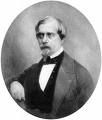
In June 1827 the first successful photograph (which he calls "heliograph") is produced by Joseph Nicephore Niepce (Nicéphore Niépce) (1765-1833) in France; it uses bitumen of Judea coated on pewter plates in a camera obscura facing a window of his estate, imaging a blurry bldg., tree, and barn after eight hours of exposure, becoming the oldest surviving photography of a real-world scene; he produced foggy photographs as early as 1822.

In 1835 English physicist William Henry Fox Talbot (1800-77) takes the earliest known negative photograph using paper coated with silver chloride in a camera obscura, Lacock Abbey, Wiltshire, and later claims to have invented photography ahead of Daguerre; he later waxes the negative, places it over another coated paper, and exposes it to sunlight to produce a positive image, becoming the first to produce multiple copies from one negative, and the first to make paper photographs ("negative positives"), which develops into modern photography, while Daguerrotypes prove to be a dead end?

In 1837 French painter Louis Jacques Mande (Mandé) Daguerre (1789-1851) invents the "miraculous" reduced exposure time Daguerreotype process of photography using a silver iodide coating on copper plates, developed with mercury fumes and washed with a salt solution to prevent darkening; he doesn't present it to the public until 1839. On Jan. 7, 1839 after partnering with Nicephore Niepce in 1829, Daguerre gives his first public demonstration of his new photographic process, and it becomes an instant hit, launching "daguerréotypomanie"; "An hour later, all the opticians' shops were seiged, but could not rake together enough instruments to satisfy the onrushing army of would-be daguerreotypists; a few days later you could see in all the squares of Paris three-legged dark-boxes planted in front of churches and palaces." (Helmut Gernsheim); on Feb. 23 the earliest report of the Daguerrotype in the U.S. appears in the Boston Daily Advertiser, which calls it a "remarkable invention"; in Sept. Robert Cornelius of Philadelphia learns the process and begins making improvements; at least two dozen men from Norway to Brazil step forward to claim precedence over Daguerre?


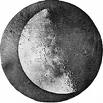

In 1839 English-born Am. scientist John William Draper (1811-82) becomes the first person in N.Y. to use the Daguerre process, and makes photographs of the Moon; a photo he makes next year of his sister Dorothy Catherine Draper becomes the oldest photographic portrait to survive to modern times; meanwhile after Louis Daguerre's invention is announced in Jan., English inventor William Henry Fox Talbot (1800-77) claims priority (1835) over Daguerre in photography and argues his case before the Royal Society.
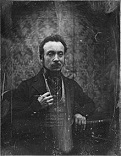
In 1841-4 French photographer Joseph-Philibert Girault de Prangey (1804-92) tours the Holy Land incl. Egypt, Syria, Turkey, Greece, and Palestine, making the first modern photographs (daguerreotypes) of Jerusalem; they are discovered in the 1920s, and first exhibited on Jan. 30, 2019 by the Metropolitan Museum of Art in New York City; in May 2003 Qatar Sheikh Saud Al Thani buys one for a world record price of Ł565,250 ($922,488).
In Jan. 1846 Welsh-born Am. immigrant civil engineer John Plumbe Jr. takes the first photo of the White House.
On Sept. 24, 1848 Charles Fontayne and William Porter take the first daguerreotype of a human in Cincinnati, Ohio?


In 1860 French photographer Nadar (Gaspard-Felix Tournachon) (1820-1910) copyrights a series of Photos of the Genitalia of a Hermaphrodite, which are later put on display at Musee D'Orsay in Paris.

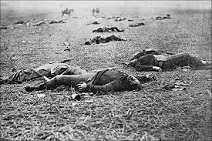
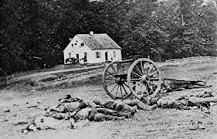
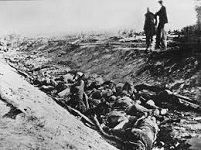
In July 1861 New York City photographer Mathew B. Brady (1822-96) begins to photograph Civil War battles with a traveling wagon studio and a number of assts., traveling with the Union armies and eventually taking over 7K pictures, his results shocking the Northern public - but not enough?

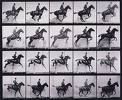
In 1872 English-born Am. landscape photographer Eadweard James Muybridge (Edward James Muggeridge) (1830-1904) using his zoopraxiscope to win a $25K bet over whether all four hooves ever leave the ground at the same time (yes); he only comes up with a single still shot this year, but shoots a galloping sequence by 1878.

In 1880 Danish-born Am. social reformer Jacob August Riis (1849-1914) uses burning magnesium powder in a frying pan as a flash to photograph New York City slums after dark, twice setting a house on fire, and once torching his own clothes; his pictures convince his friend (N.Y. assemblyman 1881-3) Theodore Roosevelt to undertake social reforms.
About 1885 the Pictorialism Movement in photography begins to become popular, manipulating photos to make them seem like paintings or engravings with an emotional component; after beginning to decline in popularity about 1920, it holds on until the end of WWII, giving way to Modernism.

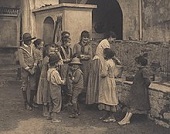
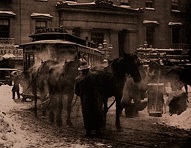
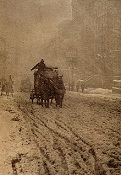
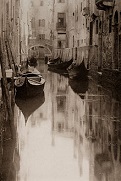

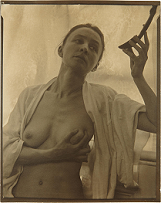
In 1887 after studying in Europe, Hoboken, N.J. Alfred Stieglitz (1864-1946) wins first place for his photograph The Last Joke, Bellagio for Amateur Photographer mag., becoming a co-ed. in 1893; in May 1896 he founds The Camera Club of New York, which begins pub. Camera Notes in July 1897, becoming the world's #1 photographic mag, going on to have a 50-year career making photography an accepted art form. In 1924 after getting her to move to New York City from Tex. in June 1918 and becomes his nude model, pissing-off his wife Emily, causing them to move in together, after which she won't grant a divorce for six years, he marries "Mother of American Modernism" Georgia Totto O'Keeffe (1887-1986), known for her paintings of women's genitalia. In 1925 he stages the exhibition "Alfred Stieglitz Presents Seven Americans: 159 Paintings, Photographs, and Things Recent and Never Before Publicly Shown by Arthur G. Dove, Marsden Hartley, John Marin, Charles Demuth, Paul Strand, Georgia O'Keeffe and Alfred Stieglitz" at Anderson Galleries in New York City, then in Dec. open his own 1-room gallery called The Intimate Gallery AKA The Room. "Photography is not an art. Neither is painting, nor sculpture, literature or music. They are only different media for the individual to express his aesthetic feelings... You do not have to be a painter or a sculptor to be an artist. You may be a shoemaker. You may be creative as such. And, if so, you are a greater artist than the majority of the painters whose work is shown in the art galleries of today."

In 1899 Constantinople-born Amherst College-educated Gilbert Hovey Grosvenor (1875-1966) (cousin of Pres. William Howard Taft and son-in-law of Alexander Graham Bell) becomes the first full-time ed. of Nat. Geographic Mag. (until 1954), building it into a top world science and learning org., and becoming "the Father of Photojournalism".

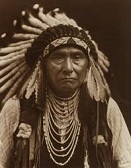
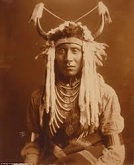
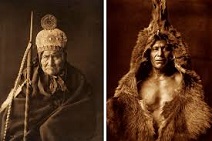
In 1906 Whitewater, Wisc.-born Seattle, Wash. society photographer Edward Sheriff Curtis (1868-1930) abandons his career to begin photographing the vanishing Am. Indians, spending 30 years photographing 80 tribes W of the Mississippi River and compiling a 20-vol. 20-portfolio set of 2.2K photos and 4K pages of text, backed by Pres. Theodore Roosevelt and partially funded by J.P. Morgan, but ending up going bankrupt as the public wants to forget the Indians and content themselves with the buffalo nickel (1913)?

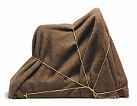


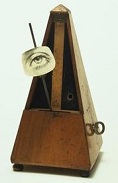
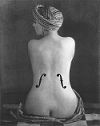

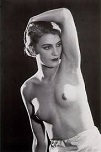
In 1920 Philly-born Surrealist visual artist Man Ray (Emmanuel Radnitzky) (1890-1976) pub. the photo Enigma of Isidore Ducasse (New York); "Chance meeting of an umbrella and sewing machine on a dissecting table". In July 1921 he moves to Montparnasse, Paris, pub. the photo Rrose Selavy (Sélavy), a pun on "Eros, c'est la vie", i.e., "eros, that's life" and "Arroser la vie", i.e., "make a toast to life", really photos of Marcel Duchamp dressed in drag. In 1923 Springfield, Ohio-born Berenice Alice Abbott (1898-1991) becomes the darkroom asst. of Man Ray in Montparnasse, Paris, going on to move to New York City in 1929 and photograph the heck out of it for posterity. In 1923 Man Ray pub. Object to be Destroyed, a metronome with a photo of an eye attached to the arm; also Rayograph, in which he places objects directly on sensitized paper and exposes them to light, producing abstract figures. In 1924 he pub. Le Violon d'Ingres; model Kiki de Montparnasse. In 1933 he pub. Veiled Erotic; modeled by Meret Oppenheim. In 1929 he hires Poughkeepsie, N.Y.-born model Elizabeth "Lee" Miller, Lady Penrose (1907-77), who becomes his lover, going on to become a photographer and take many photographs he gets credit for, helping him rediscover the photographic technique of (Pseudo) Solarization before returning to New York City in 1932 and setting up her own photography studio. Man Ray goes on to attract clientele incl. Jean Cocteau, James Joyce, and Gertrude Stein for his photo sessions before returning to the U.S. and settling in Los Angeles, Calif. in 1940, finally returning to Paris in 1951.

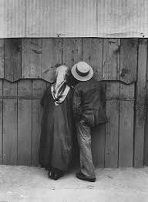
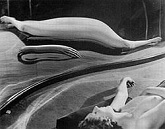
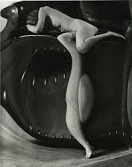
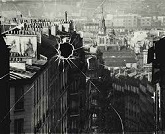
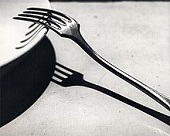
In 1925 after being wounded in WWI and winning a medal from the Hungarian Amateur Photographer's Assoc. in 1923, Budapest, Hungary-born Jewish photographer Andre Kertesz (André Kertész) (Kertész Andor) (1894-1985) moves to Paris, France, working with the Dada movement and becoming a success, earning the nickname Brother Seeing Eye (Seer) after his first solo exhibit is held in a medieval monastery full of blind monks, pioneering photojournalism with photo essays in Vu, and the book Distortions (1936), consisting of photos of reflections in circus mirrors taken from Luna Park in Coney Island before fleeing to the U.S. in 1936 and rebuilding his rep., growing into an internat. star, holding a 1-man show at the Museum of Modern Art (MoMA) in 1964, and winning a Guggenheim Fellowship in 1974; "The camera is my tool. Through it I give a reason to everything around me."
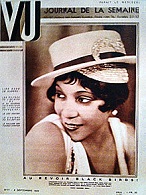
On Mar. 21, 1928 the weekly French pictorial mag. Vu (VU) begins pub. (until May 29, 1940), founded in Paris by Lucien Vogel, becoming the first ?, with contributors incl. Brassai, Henri Cartier-Bresson, Andre Kertesz, and Man Ray.

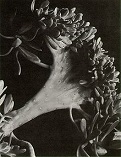
On Nov. 15, 1932 San Francisco, Calif.-based Group f/64, consisting of photographers Ansel Easton Adams (1902-84), Imogen Cunningham (1883-1976), John Paul Edwards (1884-1968), Sonya Noskowiak (1900-75), Henry Swift (1891-1962), Willard Van Dyke (1906-86), and Edward Weston (1886-1958) gives their first exhibition at the M.H. de Young Memorial Museum in San Francisco, Calif., displaying their devotion to straight photography and rejection of pictorialism, with the soundbyte: "The name of this Group is derived from a diaphragm number of the photographic lens. It signifies to a large extent the qualities of clearness and definition of the photographic image which is an important element in the work of members of this Group. The chief object of the Group is to present in frequent shows what it considers the best contemporary photography of the West; in addition to the showing of the work of its members, it will include prints from other photographers who evidence tendencies in their work similar to that of the Group"; photos in the exhibition incl. "Photograph of a succulent plant" by Cunningham (1920).

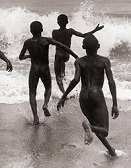

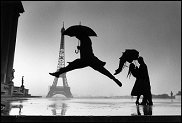
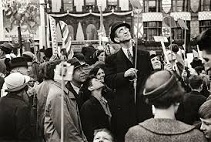
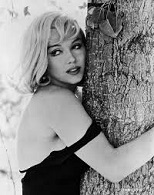
In 1932 after being inspired by the 1930 photograph Three Boys at Lake Tanganyika by Hungarian photographer Martin Munkacsi (Munkácsi) (Mermelstein Marton) (1896-1963), and acquiring a 50mm Leica camera in Marseilles, traveling around Europe taking pictures, Chanteloup-en-Brie, Seine-et-Marne-born French humanist photographer Henri-Cartier Bresson (1908-2004) stages his first exhibition at the Julien Levy Gallery in New York City, moving to the U.S. in 1935 to work there before returning to France and getting a job working for French film dir. Jean Renoir; in 1937 he covers the coronation of George VI and Queen Elizabeth of Britain for the French weekly Regards, concentrating on the crowds and neglecting to take photos of the king; in Sept. 1939 he buries his Leica and joins the French Army as a cpl. in the film and photo unit, getting captured by the Germans in June 1940 in St. Die and spending 35 mo. in POW camps before escaping (3rd attempt); in 1947 the Museum of Modern Art (MoMA) stages a retrospective of his work to go along with his new book The Photographs of Henri Cartier-Bresson; in 1947 he founds Magnum Photos with Robert Capa, Robert Seymour, George Rodger et al., becoming the first cooperative agency for global freelance photographers; in 1948 he covers Gandhi's funeral, followed in 1949 by the end of the Chinese Civil War incl. the first 6 mo. of the People's Repub. of China; in 1952 he pub. The Decisive Moment (Images a la Sauvette), with a cover by Henri Matisse; in 1957 he gives an interview to the Washington Post, containing the soundbyte: "There is a creative fraction of a second when you are taking a picture. Your eye must see a composition or an expression that life itself offers you, and you must know with intuition when to click the camera. That is the moment the photographer is creative. Oop! The Moment! Once you miss it, it is gone forever"; in 1960 he works on the set of the Hollywood film The Misfits with Marilyn Monroe, uttering the soundbyte: "You see, it's all these elements of her beauty and also her intelligence that makes the actress not only a model, but a real woman expressing herself."

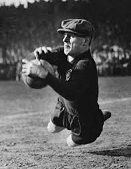
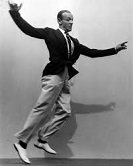
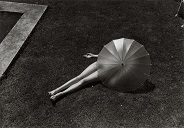
On Mar. 21, 1933 after gaining fame photographing sports and fashion, and traveling to Liberia, Egypt, London, New York, Brazil, Sicily, and Turkey, specializing in flying photos, Kolosvar, Hungary-born Jewish Berliner Illustrite Zeitung photographer Martin Munkacsi (Munkácsi) (1896-1963) photographs the Day of Potsdam when German pres. Paul von Hindenburg hands Germany over to Adolf Hitler; too bad, the Nazis shut the mag. down in 1934 and fire its Jewish ed. Kurt Korff, causing Munkacsi to flee to New York City, where he signs with Harper's Bazaar for $100K, going on to pioneer artistic sports photography, and shoot portraits of Hollywood stars Fred Astaire, Louis Armstrong, Joan Crawford, Jean Harlow, Katharine Hepburn, Leslie Howard, and Jane Russell; too bad, he dies in poverty.

In 1935 Zloczow, Galicia-born Jewish photographer Weegee (Arthur Fellig) (Usher Fellig) (1899-1968) begins his career as a freelance B&W street crime photographer; his nickname is from Ouija, from his uncanny ability to arrive at the scene of a crime before authorities; he goes on to become the first New York City reporter to have a permit for a police-band shortwave radio in his darkroom-equipped car (1938); the source of the Peter Sellers Dr. Strangelove accent?



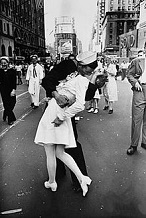
On Nov. 23, 1936 Time mag. founder Henry R. Luce begins pub. the super-popular photo mag. Life (10 cents); the first cover shows a B&W photo of Ft. Peck Dam by New York City-born Margaret Bourke-White (1904-71), who started out photographing industrial establishments in the Soviet Union in 1934 and producing the documentary films Eyes on Russia and Red Republic; meanwhile Dirchau, West Prussia-born Jewish photographer Alfred Eisenstaedt (1898-1995) joins the staff of Life mag. (until 1974), getting 2.5K photo stories and 90+ cover photos pub., incl. V-J Day in Times Square, Aug. 14, 1945 (Aug. 27); in 1963 Bourke-White pub. her autobio. Portrait of Myself.

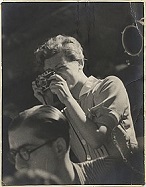
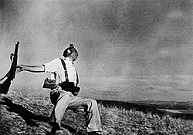
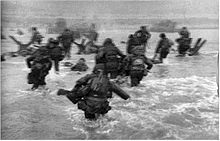
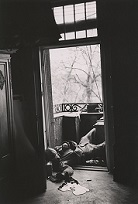
In 1936 after hooking up in Berlin, Budapest, Hungary-born Jewish photographer Robert Capa (Endre Friedmann) (1913-54) and Stuttgart, Germany-born Jewish photographer Gerda Taro (Pohorylle) (1910-37) begin covering the Spanish Civil War, they pub. the (staged?) photo The Falling Soldier: Loyalist Militiaman at the Moment of Death, Cerro Muriano, September 5, 1936), which makes Capa a star, with the Picture Post calling him "the greatest war photographer in the world"; too bad, on July 26, 1937 Taro is killed near Brunete, Spai when their vehicle collides with a tank; Capa goes on to cover Chinese resistance to Japan in Hankou in 1938 and WWII for the Allies, meeting Am. writer John Steinbeck in Algiers in 1943 and storming Omaha Beach on D-Day with U.S. troops and taking 106 photos, only to lose all but 11 in a photo lab accident in London, which are pub. in Life on June 19, 1944 under the title incl. The Magnificent Eleven, which later inspire Steven Spielberg to make the film "Saving Private Ryan" (1998); on Apr. 18, 1945 he covers the fight to secure a bridge in Leipzig, Germany, getting the photo The Last Man to Die (in WWII) (Raymond J. Bowman) pub. in the Victory in Europe issue of Life mag.; in 1947 U.S. Gen. Dwight D. Eisenhower awards Capa the Medal of Freedom.




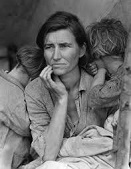
In 1936 after splitting in 1934 with the Communist Film and Photo League of the Workers Internat. Relief in Berlin (founded 1930), the Photo League (of Manhattan) is founded by 40 artists, incl. photographers Richard Avedon (1923-2004), Dorothea Lange (1895-1965), William Eugene Smith (1918-78), Paul Strand (1890-1976) to concentrate on social documentary rather than art, with the goal being to "put the camera back into the hands of honest photographers who... use it to photograph America"; too bad, the McCarthy era puts the screws on them, and in 1947 the U.S. govt. declares it subversive, and in June 1949 Strand (a Communist) leaves for voluntary exile in France, and they disband in 1951. In 1936 Lange pub. the photo Migrant Mother, which becomes the poster girl of the Great Depression.

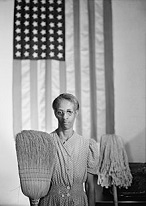

In 1937 Fort Scott, Kan.-born Gordon Roger Alexander Buchanan Parks (1912-2006) takes up photography after buying his first camera in a Seattle, Wash. pawnshop, moving to Chicago, Ill. in 1940 and joining the U.S. Farm Security Admin. in 1941, where he pub. the photo American Gothic, Washington, D.C., a black comment on Grant Wood's "American Gothic"; in 1948-68 he becomes the first black photographer for Life mag.; he goes on to become a filmmaker, the first African-Am. to produce and direct major motion pictures, incl. Shaft (1971), founding the Blaxploitation Genre.

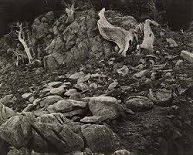
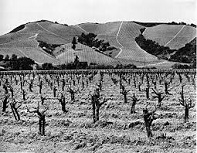
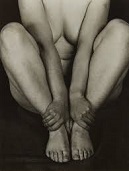
In 1937 after abandoning soft focus pictorialism for highly-detailed photographic images, Highland Park, Ill.-born Edward Henry Weston (1886-1958) becomes the first photographer to win a Guggenheim Fellowship, going on to produce 1.4K 8x10 negatives by 1939, focusing on the trees and rocks in his adopted home of Point Lobos, Calif., and nearby Death Valley, Calif.; "Anything more than 500 yards from the car just isn't photogenic."


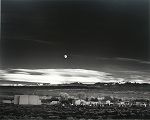
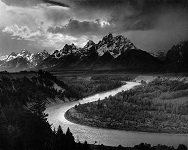
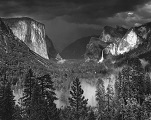
In 1939 San Francisco, Calif.-born photgrapher Ansel Adams (1902-84) (known for B&W photos of the Am. West esp. Yosemite Park) and Ga.-born photographer Fred R. Archer (1889-1963) (who worked for Universal Pictures and Warner Bros. in the 1920s, pub. an article with Elmer Fryer in 1928 titled "Still photography in motion picture work", pushing the slogan "The still sells the movies") develop the Zone System for determining optimal film exposure and development. In 1941 Adams pub. the photo Moonrise, Hernandez, N.M.. In 1942 he pub. The Tetons and the Snake River, which becomes one of 115 images on the Voyager Golden Record aboard the Voyager spacecraft in 1977. In 1945 he pub. Thunderstorm, Yosemite Valley.

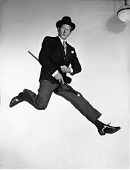
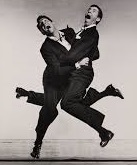
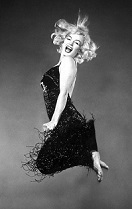
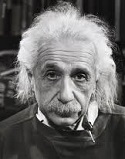
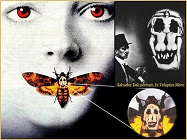
In 1941 after being falsely imprisoned for his father's murder in 1928 and pardoned by Austrian pres. Wilhelm Miklas in Oct. 1930, then moving to Paris followed by Marseille before fleeing to the U.S., Riga, Latvia-born Jewish portrait photographer Philippe Halsman (1906-79) sells his photograph of model Constance Ford to the cosmetics firm of Elizabeth Arden for use in their Victory Red lipstick advertising campaign, going on to be hired in 1942 by Life mag., producing many covers incl. Winston Churchill, Jean Cocteau, Dorothy Dandrige, Judy Garland, Dean Martin and Jerry Lewis, Marilyn Monroe, and Pablo Picasso; meanwhile in 1941 he meets Surrealist artist Salvador Dali (1904-89, resulting in the 1954 book "Dali's Mustache", and In Voluptas Mors (Lat. "a desirable death") (1951), a skull formed by seven nude women, which is later used in the poster for the 1991 film "The Silence of the Lambs" (1991); in 1947 he takes a famous photo of Albert Einstein lamenting the A-bomb; in 1951 Halsman is hired by NBC-TV to photograph popular comedians while jumping, incl. Milton Berle, Sid Caesar, Bob Hope, and Groucho Marx, leading to his creation of jumpology and the 1959 book "Philippe Halsman's Jump Book", leading to the 2007 film Jump! starring Ben Silverstone; in 1958 Popular Photography lists him in its World's Ten Greatest Photographers; "I drifted into photography like one drifts into prostitution. First I did it to please myself, then I did it to please my friends, and eventually I did it for the money."

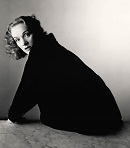
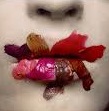
In Oct. 1943 Plainfield, N.J.-born photographer Irving Penn (1917-2009) has his first cover pub. by Vogue mag., going on to become known for fashion photography, usually with a simple grey or white backdrop, with subjects incl. Marlene Dietrich, Marcel Duchamp, Martha Graham, Georgia O'Keeffe, Pablo Picasso, and Igor Stravinsky; in 1948 he takes a set of famous photos of children in Cuzco, Peru; in 1986 he pub. Mouth.

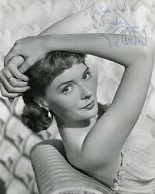
In 1944 New York City fashion photographer Richard Avedon (1923-2004) marries model Dorcas Marie Nowell (1925-2011), who becomes known professionally as Doe Avedon; they divorce in 1949; "His fashion and portrait photographs helped define America's image of style, beauty and culture for the last half-century" (New York Times).
In 1944 the Society of Magazine Photographers is founded in New York City by 24 photographers, changing the name to Am. Society of Mag. Photographers in 1945, and Am. Society of Media Photographers (ASMP) in 1992; in 1945 Philippe Halsman (1906-79) becomes pres #1.
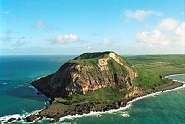

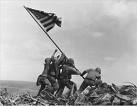



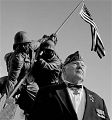
The U.S. gets its own version of the White Cavalry to the rescue scenario with the $14 Billion Photo? On Feb. 19, 1945 (dawn) the 28th U.S. Marines (110K, biggest Marine force ever) storm barren 5.5 mi. x 2.5 mi. Iwo Jima (Naka Iwo) (Iwo To) (Jap. "sulfur island") (710 mi. S of Tokyo) (largest of the Volcano Islands), the strongest bastion of the Japanese outer-defense system (containing three airfields), commanded by Gen. Tadamichi Kuribayashi (1891-1945), whose brilliant defense stretches out the capture from five to 36 days; 35K Marines land by nightfall at Toblishi Point in the S, beginning a 5-week battle to seize it from the Nips, er, Japs, er, Japanese, so that it can support long range B-29 bombers; 6.8K U.S. troops are KIA, 13K are wounded (19,938 total casualties), and the entire force of 20K Japanese are KIA or commit hari-kiri before the U.S. captures it, becoming the deadliest battle in U.S. Marine Corps history (until ?), generating 22 Medals of Honor; on Feb. 23 after killing 19K of the 20K Japs, extinct 555-ft. (169m) volcano Mount Suribachi (Jap. "grinding bowl") (Mount Pipe, from the times when sulfur gas and water vapor roll down from the summit, resembling a smoking pipe) on the S end is captured; at 11:30 a.m. AP photographer Joseph John "Joe" Rosenthal (1911-2006) takes a 4x5 Speed Graphic B&W (1/400th of a sec.) Photo of the Raising of the U.S. Flag on Mt. Suribachi in Iwo Jima on a water pipe on the 556-ft. summit by five Marines and Navy corpsman John Henry "Jack" "Doc" Bradley (1923-94), which becomes a symbol of the war and later of the Marines, winning him a Pulitzer Prize and becoming the most reprinted photo of the Pacific war; it later comes out that another (smaller) flag was raised at 10:20 a.m. on a water pipe when a photo by Marine Sgt. Louis R. "Lou" Lowery (1916-87) is pub. in Leatherneck mag. in 1947; Marine Sgt. William Homer "Bill" Genaust (b. 1907) also photographs the 2nd raising with a 16mm Bell & Howell movie camera (198 frames), but dies nine days later on Mar. 4 in a cavern in Hill 362A before he can view the film, which is played in movie theaters without giving him credit; of the 12 Marines who raised the two flags, six later die in battle, and four are wounded; the island takes until Mar. 17 to capture, with the last Japs defying all odds to hold out with little food and water, and becomes an airstrip for damaged bombers, then is returned to Japan in 1968, where Old Glory flies on it four days each year; U.S. PFC Jack H. Lucas (1928-), who lied about his age to enter the U.S. Marines at age 14 becomes the youngest Am. in the 20th cent. and the youngest Marine ever to win the Medal of Honor after he jumps onto two enemy grenades to save three fellow soldiers; the photo is used on the 3-Cent Iwo Jima Flag-Raising Stamp (first U.S. stamp to show a WWII scene) to revive flagging war spirit stateside and raise $14B for the war effort, even though it doesn't do anything for the spirit of the troops in the field; after the battle, a Marine carves a depiction of the flag-raising on a large sandstone on the N shore.

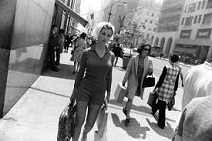
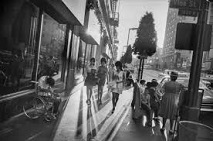
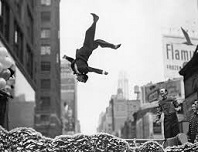
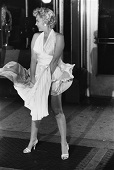
In the early 1950s street photographer Garry Winogrand (1928-84) begins photographing New York City; "In the 1960s and 70s, he defined street photography as an attitude as well as a style – and it has laboured in his shadow ever since, so definitive are his photographs of New York." He dies in Tijuna, Mexico on Mar. 19, 1984 of gall bladder cancer, leaving thousands of rolls of half-processed film and 300K unedited images; in 1955 he takes a famous photo of Marilyn Monroe on the set of "The Seven Year Itch".

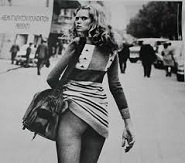
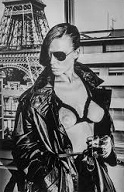
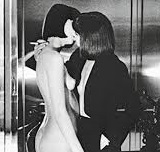
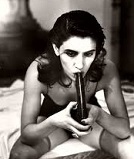
In May 1953 after fleeing Germany on Dec. 5, 1938 and arriving in Sidney, Australia on Sept. 27, 1940 via Singapore, serving with the Australian army as a truck driver during WWII, Berlin-born photographer Helmut Newton (Neustädter) (1920-2004) holds his first exhibition in Melbourne titled "New Visions in Photography" before leaving for London in 1957 with his actress-photographer wife (since 1948) June Browne (Brunell) (1923-) AKA Alice Springs, winning a contract with British Vogue for fashion photography, ending up in Paris in 1961 and becoming known for stylized eroticism with sadomasochistic and fetishistic subtexts.


This is what it sounds like when the doves cry, Or, The 1954 Brown v. Board of Ed. Supreme Court Decision inflames racial hatred throughout the Southy South South Johnny Reb KKK South, and the good die young? On Aug. 28, 1955 two white men take visiting 14-y.-o. black Chicagoan Emmett Louis "Bobo" Till (b. 1941) from his uncle's Mississippi Delta home in the town of Money after being angered over his whistling at white woman Carolyn Bryant at her hubby Roy's store; in Aug. his mutilated body is found in the Tallahatchie River; his mother Mamie Till Mobley holds an open coffin funeral in Chicago which is viewed by 50K visitors, galvanizing opposition to segregation and Jim Crow; he is buried in Burr Oak Cemetery in Alsip, Ill.; Roy Bryant and his half-brother J.W. Milam are acquitted by an all-white jury, and later admit their guilt to Look mag., but can't be retried; a U.S. atty. charges them with kidnapping but a grand jury refuses to indict, causing the FBI to reluctantly close their file, but in June 2005 federal authorities unearth his casket in an effort to prosecute somebody, anybody before they all kick off scot-free; in 2017 Bryant admits that her story was false; Memphis, Tenn.-born Ernest Columbus Withers Sr. (1922-2007), one of the first African-Am. police officers in Memphis, Tenn., who turned photojournalist covers the murder trial, bringing nat. attention to Southern racial violence, going on to travel with MLK Jr. and cover the Montgomery Bus Boycott, the Sanitation Workers Strike, Negro League baseall, and Memphis blues and soul musicians; he was an FBI informant?

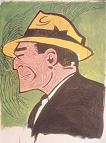

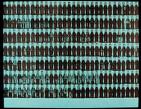
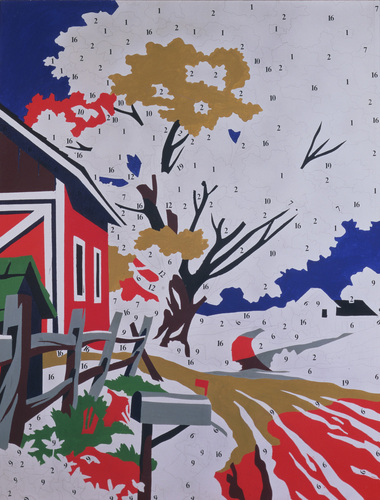
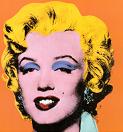
On July 9, 1962 Pittsburgh, Penn.-born Pop Art multimedia artist-photographer Andy Warhol (Andrew Warhola) (1928-87) (a master of silkscreen paintings based on photos) holds his first West Coast exhibition in the Ferus Gallery in Los Angeles, Calif., followed on Nov. 6-24, 1962 by an exhibition at Eleanor Ward's Stable Gallery in New York City, featuring his creations "Marilyn Diptych", "100 Soup Cans", "100 Coke Bottles", and "100 Dollar Bills", launching his stellar career.


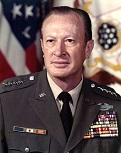


Tut tut tut, it's Tet? On Jan. 30, 1968 (night)-Mar. 7 the surprise Tet Offensive sees 84K Viet Cong guerrillas and NVA troops attack all U.S. bases in Vietnam (36 South Vietnamese provincial capitals, 60 towns and five large cities); Saigon is attacked, incl. the airfield, pres. palace, and U.S. embassy by 17 Viet Cong commandos (Jan. 31), freaking out the TV-watching U.S. public after years of TV news assuring them that the enemy is almost kaput; luckily U.S. Col. (later Gen., last cmdr. of U.S. military ops in Vietnam in 1972-3) Frederick Carlton "Fred" Weyand (1916-2010) (a WWII vet) sensed the attack and had troops positioned to protect Saigon, and on Feb. 1 they drive the North Vietnamese out of Tan Son Nhut Airport, stopping a possible capture of the South Vietnamese military HQ; on Feb. 1 Saigon police chief Gen. Nguyen Ngoc Loan (1921-98) executes a plaid-shirt-wearing Viet Cong Lt. with a Nazi-style pistol shot to the head in the street in a scene captured in a famous News Photo of a 1968 Street Execution of a Captured Viet Cong (The Saigon Execution) by AP photographer Eddie Adams (1933-2004) (along with color footage by NBC cameraman Vo Suu), which becomes a crystallizer of popular opposition to the war, saying everything about the senseless chaos and why the U.S. has no business being halfway around the world, although the real story that the whole week was marked by thousands of insurgents being killed while the latter do their bad deeds also, wreaking atrocities on civilians incl. beheading of women and children, and that the VC Lt. was the leader of a terrorist gang who killed the family of one of Loan's deputy cmdrs. is lost in the confusion of mass change of public opinion balance; "Two people died in that photograph; the general killed the Viet Cong; I killed the general with my camera" (Adams); the same day (Feb. 1) Elvis and Priscilla Presley give birth to their daughter Lisa Marie Presley (1968-); Nguyen Ngoc Loan leaves Vietnam in 1975, and opens a pizza restaurant in Va. until public disclosure causes him to close it in 1991; all 105 cities attacked are successfully defended by Mar. 7, with 11K total dead, but it is a psychological V for the Viet Cong, causing the U.S. pop. to begin turning against the war irreversibly, helped on Feb. 8 by Robert F. Kennedy (always at the forefront?) publicly stating that the U.S. cannot win the war; meanwhile during the Tet Offensive anti-Vietnam War activists Rev. Daniel Berrigan (1921-) (a Jesuit) and historian Howard Zinn (1922-2010) visit Hanoi, getting three U.S. POW airmen released (first of the war); Zinn goes on to edit "The Pentagon Papers" for Daniel Ellsberg - a shoe-in to win the pres. nomination now?

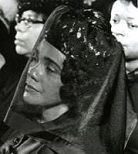
In 1969 Owensboro, Ky.-born photographer Moneta Sleet Jr. (1926-96) wins the Pulitzer Prize for feature photography for a photograph of MLK's widow Coretta Scott King at his funeral, becoming the first African-Am. to win a journalism award, and the first African-Am. man to win a Pulitzer Prize.


On June 8, 1972 U.S. heli pilot Capt. John Plummer (1947-) (an operations officer) orders the bombing of the village of Trang Bang, Vietnam 25 mi. W of Saigon; AP photographer Huynh Cong "Nick" Ut (1951-) takes a photo of screaming children suffering from napalm, incl. cute little naked 9-y.-o. Phan Thi Kim Phuc (1963-), drawing internat. attention; the injured children are taken to a hospital in Saigon, and Phan returns home after 14 mo. and 17 operations, after which she becomes a North Vietnamese propaganda tool, studies medicine, converts to Christianity in 1982, and emigrates to Canada in 1992; after seeing it pub. in the newspaper on June 12, 1972 Tricky Dicky tells H.R. Haldeman that he thinks the photo was "fixed"; in 1998 Plummer, a pastor at Bethany United Methodist Church in Purcellville, Va. meets with Phuc at the Vietnam Veterans Memorial in Washington D.C., and she forgives him, after which he admits that he lied about ordering the attack, because the plane that dropped the bombs was piloted by a South Vietnamese pilot, meaning that it was Vietnamese burning their own countrymen, and it was the Americans that saved her - with all these subliminal kiddie porno associations it's a sure winner?

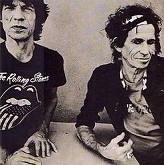
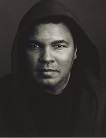
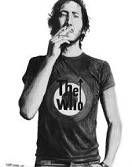
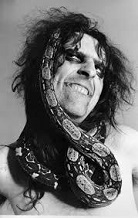

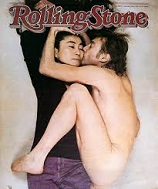
In 1973 after photographing The Rolling Stones in San Francisco, Calif. in 1971-2, Waterbury, Conn.-born Jewish lesbian Anna-Lou "Annie" Leibovitz (1949-) becomes chief photographer of Rolling Stone mag. (until 1983), going on to define its look, becoming known as "the Portraitist of the Rock Generation"; on Dec. 8, 1980 (5:00 p.m.) she takes the famous photo of naked John Lennon and clothed Yoko Ono smooching on the floor, becoming the first photographer to professionally shoot Lennon, and the last when he is shot and killed five hours later (10:49 p.m.); she goes on to work for Vanity Fair mag.

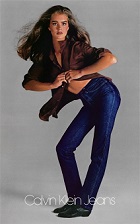

In 1978 Bronx, N.Y.-born Jewish fashion designer Calvin Richard Klein (1942-) introduces his tight-fitting signature jeans, which sell 200K pairs the first week, launching his career of pushing ordinary clothing items for sex appeal, incl. men's underwear in the early 1980s; in 1980 he launches an ad campaign featuring 15-y.-o. Brooke Shields asking "Do you want to know what comes between me and my Calvins? Nothing", which are banned by some stations; the photographer is New York City fashion photographer Richard Avedon (1923-2004); in 1995 his ads are criticized as "kiddie porn". On Nov. 19, 1980 CBS-TV rejects a Calvin Klein Jeans Ad Featuring Brooke Shields, where she utters the soundbyte "You know what comes between me and my Calvins? Nothing."


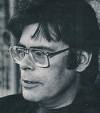


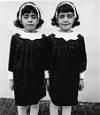
On May 23, 1980 Stanley Kubrick's The Shining (Peregrine Productions) (Hawk Films) (Warner Bros.) debuts, based on the 1977 Stephen King novel about failed writer Jack Torrance (Jack Nicholson) getting cabin fever at the secluded Overlook Hotel in Colo. during the winter; features the great climax where he goes after his family with an axe, crying, "Here's Johnny!"; title is inspired by John Lennon's "Instant Karma" and its line "We all shine on"; Joe Turkel plays creepy Joe the Bartender; the disturbing 1967 photograph Identical Twins, Roselle, N.J. of Lisa and Louise Burns (1968-) by Diane Arbus is used for effect; Danny Lloyd plays the psychic kid who talks with his finger and spouts "Redrum!"; bizarrely skinny scarecrow Shelley Duvall plays his freaked wife, and Scatman Crothers plays psychic vacationing chef Dick Hallorann, who returns to get axed; the photo at the end shows the hotel on July 4, 1921 as "Midnight, the Stars, and You" is being played; "All work and no play make Jack a dull boy"; the film contains numerous codes revealing that Kubrick directed a govt.-backed fake Apollo 11 moon landing based on his experience filming "Doctor Strangelove" (1964) and "2001: A Space Odyssey" (1968)?; it's no surprise that the record for altitude was 853.8 mi. (1,374.1km) for Gemini 11 on Sept. 14, 1966?


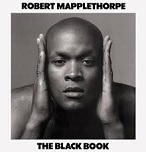
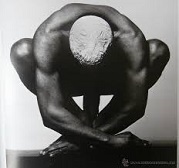
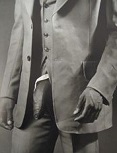
On July 15, 1986 after chronicling the underground BDSM scene in New York City in the late 1960s and early 19702, Floral Park, N.Y.-born gay erotic photographer Robert Mapplethorpe (1946-89) and Ntozake Shange (Paulette Williams) (1948-) pub. Black Book, photos, based on the 1986 solo exhibition "Black Males", pissing-off critics for exploitation. In summer 1989 Mapplethorpe stages the solo Perfect Moment Tour, raising obscenity to a nat. issue and making him a celeb. after he croaks on Mar. 9, 1989 of AIDS in Boston, Mass.

On Apr. 21, 2009 New York City-born street photographer and nanny Vivian Dorothy Maier (1926-2009) dies unknown in Chicago, Ill. after taking over 150K photographs of New York City, Chicago, and Los Angeles, after which in Oct. 2009 Chicago collector John Maloof publicizes her work on Flickr, making her go viral; on Sept. 9, 2013 Maloof debuts his documentary film Finding Vivian Maier (ITC Films) at the Toronto Internat. Film Festival, which is nominated for a best documentary feature Oscar.